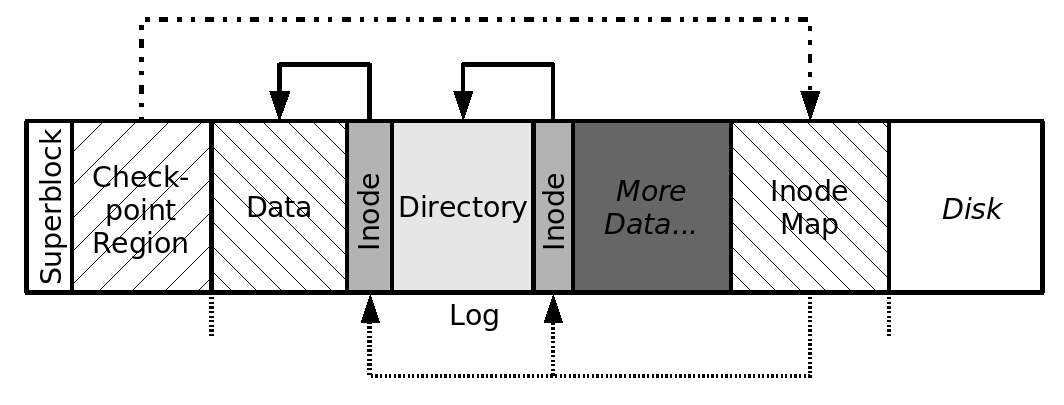Log-Structured Filesystem
A log-structured filesystem is a novel disk storage management technique developed in the late 1980's by John K. Ousterhout and Fred Douglis. It stores data sequentially on the disk rather than scattering blocks all over the disk as most other filesystems do.
Overview

Most inode-based filesystems store inode and data blocks seperately in fixed regions on the disk. Figure 1 shows a simplified disk layout of classic inode-based filesystems. This layout induces a substantial seek overhead when writing files (with read operations this overhead can be cached away). When writing a file the data blocks are written first, then the inode of the file, then the corresponding directory block is updated, then its associated inode is updated. All these operations are preceded by seek operations to locate the on-disk position of the block that is to be accessed. With workloads like those found in office applications that work on many, small files the seek operations consume up to 80% of the raw disk bandwidth.
The log-structured filesystem tries to remove this overhead by eliminating all seeks and thus reclaiming almost 100% of the disk bandwidth for write operations.
LFS in Detail

The basic idea of a log-structured filesystem is to store all information sequentially on disk in a log structure. This includes all data blocks, inode blocks, directory blocks, indirect blocks, etc. New information is buffered in a write cache and written to disk in a single, large write operation. This way many, small, synchronous writes of traditional filesystems are translated to few, large, asynchronous, sequential write operations.
Reading and Writing Data
One problem that obiously arises from this layout is that since inodes are not at fixed positions some way must be found to locate inodes. This is achieved by storing extra information in the log, the Inode Map Blocks. Inode map blocks store information about all inodes written during one write operation. To keep track of all inode map blocks they are referenced from the Checkpoint region. The inode map is compact enought to be kept in memory, so inode map lookups rarely require disk access. The inode number is used as and index into the inode map and yields the block address of the inode block on disk. From this point on the number of I/Os necessary are the same as in traditional filesystem. With the assumption that files are cached and that caches are large enough to satisfy the majority of the read requests, the LFS performs as good as FFS or better.
Free Space Management
A more challengin design issue with LFS is the management of free space. The goal here is to maintain large free space to write new date. Unfortunately by the time the log reaches the end of the disk, free space is likely to be fragmented into many small extents. There are basically two choices of how to reuse free data blocks: Threading and Copying.
Threading means, that the filesystem by some means keeps track of freed blocks and reuses these blocks when writing new data. This is what many other filesystems actually do and where a lot of effort is put into, to make it perform well. The big downside with this choice in LFS is that threading causes severe fragmentation. At some point large, continguous write are impossible, so a lot of time is spent with seeking again and the LFS will perform no better than other filesystems.
Copying on the other side means that live data is copied to contingous blocks (defragmented) and free data blocks are collected to large groups.